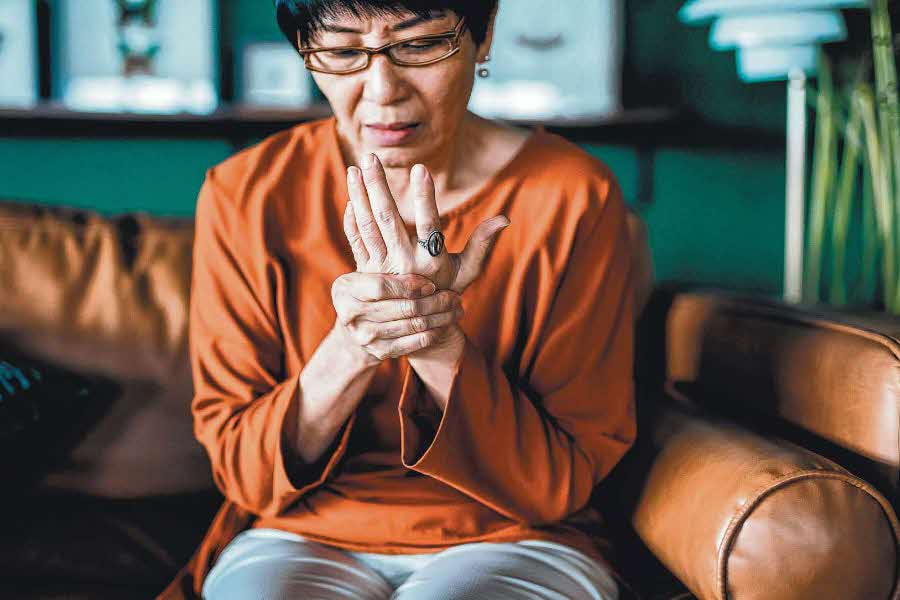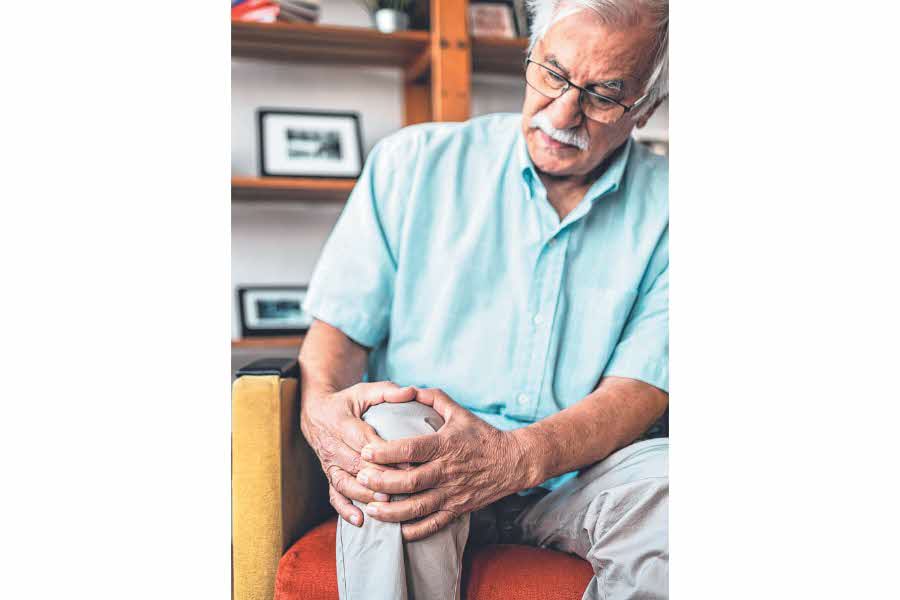 Some people with arthritis may find that gentle massages help improve joint mobility, but only in the short term. PHOTO: ISTOCKPHOTO
Some people with arthritis may find that gentle massages help improve joint mobility, but only in the short term. PHOTO: ISTOCKPHOTO
The Straits Times (11 September 2024)
began experiencing unusual tiredness, joint pains and stiffness.
The managing director of a company in the tooling industry thought she was overworked, but the issues persisted despite her trying to rest. She even fell because of stiffness in her left leg.
She was diagnosed with rheumatoid arthritis in 2014 and started specialist treatment at Tan Tock Seng Hospital (TTSH).
The 64-year-old tells The Straits Times via e-mail that she has tried numerous ways to address her pain, to no avail. Over-the-counter medication, pain plasters and creams, and massages offer only short-lived relief at best.
“The pain is especially throbbing and aching first thing in the morning,” she says.
Imagine having trouble buttoning a shirt, using cutlery or walking a few steps. That is the reality of many people with arthritis, who find that inflammation and pain in the joints affect their ability to do everyday activities.
Many seek relief from the pain in over-the-counter painkillers and plasters, or home remedies such as massages or hot showers.
In parts of Europe, a traditional remedy is to wrap the affected joint in a cabbage leaf. A 2016 study by researchers from Germany and Australia found some anecdotal evidence to support the efficacy of the cabbage leaf wrap as a pain reliever. A 2022 study by Polish researchers suggests that cabbage leaves might have an antiinflammatory effect.
Home remedies may be cheaper and seemingly gentler on the body – warm showers are certainly more soothing than popping strong over-the-counter painkillers. However, are they really useful in managing pain from arthritis? Here is what doctors said.
100 TYPES OF ARTHRITIS, HUNDREDS OF PAINS
According to adjunct assistant professor Koh Li Wearn, who is a senior consultant at TTSH’s Department of Rheumatology, Allergy, and Immunology, the term “arthritis” refers to diseases affecting the joint that typically result in pain and affect the function and movement of the joint.
“There are more than 100 different types of arthritis, and different types may affect people of different ages,” says Dr Koh.
Dr Glenn Low, a general practitioner at DTAP Clinic @ Holland Village, says the body initiates an inflammatory response as a result of a trigger, or to get rid of harmful substances, and a person experiences pain, swelling and warmth as a result.
“In certain cases, the trigger that caused the inflammation continues to persist or the inflammatory process itself becomes dysfunctional, giving rise to various arthritic medical conditions,” says Dr Low.
Common types of arthritis include gout, as a result of uric acid crystals deposited in the joints; rheumatoid arthritis, an autoimmune condition in which the immune system attacks the joints; or osteoarthritis, in which wear and tear cause changes in the joint.
For patients with hand osteoarthritis, the pain and stiffness may affect other routine actions such as using utensils to eat, opening doorknobs or performing household chores.
DR PHANG KEE FONG, consultant with Alexandra Hospital’s Division of Rheumatology, Department of Medicine
“Osteoarthritis and gout are the two conditions most seen in primary care and general practice,” says Dr Low.
By the time patients see a doctor, most are suffering enough pain to interfere with their quality of life, he adds.
While there are no recent statistics on how many suffer arthritis in Singapore, studies in 2016 and 2018 indicate that 11 per cent of the population could have knee osteoarthritis.
Dr Phang Kee Fong, consultant with Alexandra Hospital’s Division of Rheumatology, Department of Medicine, says that pain due to osteoarthritis can severely limit patients’ mobility and ability to climb stairs. “For patients with hand osteoarthritis, the pain and stiffness may affect other routine actions such as using utensils to eat, opening doorknobs or performing household chores.”
Inflammatory arthritis, of which rheumatoid arthritis is a type, affects about 1 per cent of the population, he adds, including young people and the middle-aged. It can affect their ability to work as well.
Chronic pain is a major issue that the National Arthritis Foundation (NAF) tries to help with. The charity offers those with arthritis support, such as through peer support groups and subsidised home physiotherapy services.
Chronic pain has mental, physical and social consequences, says NAF executive director Gerald Koh. “Emotional and psychological challenges, such as anxiety and depression, can arise from dealing with a chronic illness, especially if one has significant physical limitations,” he adds. Pain relief and improving mobility are thus key parts of treating arthritic medical conditions.
HOT WATER CAN HELP
Dr Jerry Chen, consultant orthopaedic surgeon and medical director of Alps Orthopaedic Centre, says some of his patients find relief in soaking in a bath of Epsom salts, or magnesium sulphate.
“While some patients report temporary relief, it’s unclear whether this is due to the magnesium or warm water and relaxation,” he adds.
Dr Koh Li Wearn of TTSH says soaking in warm water is probably the relieving factor, rather than the Epsom salts. “The warmth is relaxing and the water supports most of the body weight, hence taking stress off the joints.”
Hydrotherapy or rehabilitation activities carried out in water can help arthritis sufferers manage pain and improve mobility, says NAF’s Gerald Koh. The charity hopes to train volunteers to conduct such sessions.
Hot showers might also help manage arthritic pain. Dr Kelvin Tan, an orthopaedic consultant surgeon at private practice Singapore Sports and Orthopaedic Clinic, says: “Heat, and therefore warm water, relieves pain by increasing the blood flow to the region and increases connective tissue elasticity.”
People might also find relief through cold compresses. “A cold compress relieves swelling and pressure in the affected areas, and reduces muscle spasms and metabolic demands in the affected areas,” adds Dr Tan.
Dr Andrew Fang, a family physician at private medical chain Doctor Anywhere, says: “The key is to use heat for stiffness and cold for inflammation.
“However, prolonged exposure to extreme temperatures could cause burns or frostbite, so it’s essential to limit application times to 15 to 20 minutes.”
 Pain from knee osteoarthritis can affect a person’s ability to move. PHOTO: ISTOCKPHOTO
Pain from knee osteoarthritis can affect a person’s ability to move. PHOTO: ISTOCKPHOTO
GENTLE MASSAGES
Some people with arthritis find that massaging their joints gently can help improve mobility and provide some pain relief.
Dr Tan says that massages offer only short-term relief, and research has not established any long-term benefits. Any benefit probably comes from the stretching of the joints during the massage as well as releasing tension from the muscles surrounding the joint, plus any heat or warmth applied during the massage.
Dr Fang says massages can improve circulation and reduce muscle tension, helping patients relax.
“When combined with oils such as olive oil, which has anti-inflammatory properties, massages can offer some relief from pain and stiffness. Essential oils like lavender or eucalyptus may provide additional calming effects due to their soothing aromas,” he adds.
Dr Fang warns that aggressive and deep tissue massage can worsen arthritis, and one should use gentle techniques and avoid massaging directly over severely inflamed joints. He suggests working with a therapist who knows how to manage arthritic conditions.
INDIVIDUAL RESPONSES VARY,
SEEK TREATMENT EARLY
relief, but the downside is that it
may prevent patients from
seeking medical help in the early
stages.
Dr Ang Kian Chuan, an orthopaedic
surgeon at private practice
SBF Sports and Hand Centre, says
it is more important to seek
medical help early, get the correct
diagnosis and start treatment.
Treatment options include rest,
medication, physiotherapy and
surgery.
Individual variation in response
means that not every treatment
works for every patient, he adds.
Dr Fang says: “Each patient is
unique, and the best approach is
often a combination of medical
management, lifestyle changes
and safe home remedies.”
He notes that corticosteroid
injections may help some patients
manage pain. However, he had a
75-year-old patient who found
that these injections kept the pain
at bay for only a few months.
In the end, she had total knee
replacement surgery for both
knees. Post- surgery physiotherapy
helped her regain function.
“Today, she remains active, regularly
going to the gym and taking
daily walks,” says Dr Fang.
Dr Chen says exercise is crucial
in managing arthritis. He adds:
“Low-impact activities like swimming,
cycling and walking help
maintain joint mobility and muscle
strength, reducing pain and
preventing further joint damage.
Physiotherapy can also be invaluable,
teaching patients specific
exercises to strengthen the muscles
around their joints, improve
flexibility and manage pain.”
He notes that studies have
shown that yoga and taiji in
particular may help arthritis
sufferers. “These therapies can help improve flexibility, reduce
stress and manage pain,” he says.
Dr Koh Li Wearn says that overweight
patients with lower back
and joint pains can benefit from
weight reduction strategies.
Some people may need aids
such as a walking stick to help
them move. Correcting joint
misalignment can also help with
managing pain.
“If someone with flat feet has
pain around his or her heels, ankles
and knees, then a visit to the
podiatrist for assessment of his or
her footwear and supportive
insoles in the shoes may relieve
his or her symptoms,” she says.
Sleep is also important, she
adds. Someone with poor sleep
will perceive his or her pain more
strongly.
In Madam Tan’s case, she is on
medication to manage her autoimmune
condition.
At the start, she struggled with
stress, anxiety, loss of appetite
and the inability to accept her
illness. She now thinks more
positively and finds that exercise
helps with mood and
chronic pain.
She also does yoga stretches
on the bed every morning for 15
to 20 minutes, which helps
with morning aches.
She swims and does yoga
weekly, but also listens to her
body. If there are flare-ups of
her condition, she will slow
down her activities, including
work, and take a break.
“Mentally, I have now accepted
my condition and learnt to
manage my pain,” she says. “My
life is back to normal.”